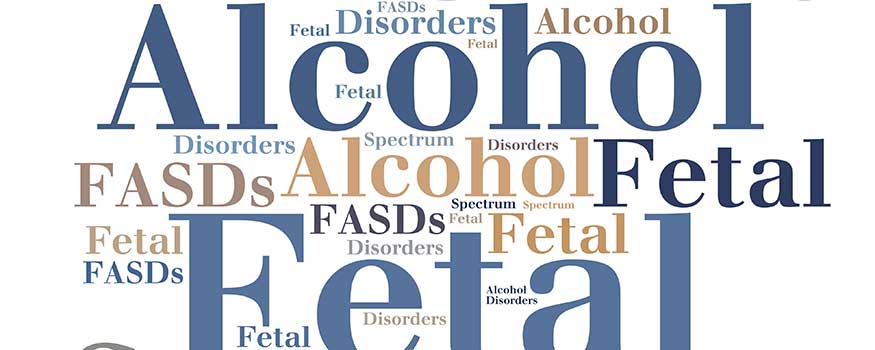Alcohol: A teratogen
Unlike all other substances of abuse, alcohol is a teratogen. Teratogens can alter both the structure and function of fetal cellular development. The impact of alcohol use on each fetus is highly variable and can be unpredictable. It can be influenced by maternal genetics, fetal genetics, timing and dose of the alcohol, maternal nutritional status, maternal age, gravida/parity, stress level, and other medication or substance use. Prenatal alcohol exposure can result in FASDs, which are a range of lifelong physical, mental, and neurobehavioral disorders that may affect 2%-5% of the population of the U.S.1 FASDs are the leading cause of preventable intellectual disability.
What is an FASD?
• Fetal alcohol spectrum disorders include fetal alcohol syndrome (FAS and partial FAS) and/or evidence of underlying non-progressive brain damage such as static encephalopathy and neurobehavioral disorder (University of Washington terms).
• Fetal alcohol syndrome must meet specific medical criteria, including growth deficiency; have evidence of organic brain dysfunction; and have three cardinal facial features. Only 9%-10% of individuals with an FASD meet these criteria.
• Cardinal facial features form in the 3rd week of gestation. Most individuals with an FASD have few physical signs of prenatal alcohol exposure—they may have a hidden disability.
FASDs are 100% preventable!
Who is at risk of having a child with an FASD?
An estimated 3.3 million sexually active reproductive-aged women per month are at risk of an alcohol-exposed pregnancy.2 1 in 10 pregnant women in the U.S. (aged 18-44) reports drinking in the past 30 days. In addition, 3.1% of pregnant women report binge drinking.3 Women who drink prior to pregnancy may be more likely to drink during pregnancy, and many women drink during the first trimester, before they are aware of the pregnancy.
Among pregnant women, alcohol use is highest among women who are:
• Aged 35-44
• College graduates
• Unmarried
No amount of alcohol has been found to be safe during pregnancy, but binge-pattern drinking increases the risk for the fetus. Binge drinking for women means having 4 or more standard drinks on any one occasion (within approximately 2 hours).
There are two ways to think about reducing alcohol-exposed pregnancies: (1) help women moderate ‘at-risk’ drinking patterns and (2) advocate effective contraception use by all reproductive-aged women who consume alcohol. ‘At-risk’ drinking patterns: more than 1 standard drink per day, more than 3 standard drinks per occasion, and/or more than 7 standard drinks per week.
For women who are not currently pregnant:
• Regularly screen women for ‘at-risk’ alcohol use and have conversations about their contraceptive use and effectiveness. Inform women about healthier drinking patterns, and follow up at each visit with women who engage in risky drinking.
• Advise women who are actively trying to conceive to abstain from alcohol.
For women who are currently pregnant:
• Reinforce the message that there is No Safe Amount, No Safe Time, and No Safe Type of alcohol, and that quitting at any time in the pregnancy can help the baby.
• For women who become pregnant unintentionally (45% of pregnancies in 2011), say to them Tell me when you last used alcohol in a matter-of-fact way. If necessary, have an honest conversation about the potential risks for their fetus, and how alcohol exposure may present in their child’s future. Don’t blame or shame them; be factual and supportive.
Abstaining from alcohol is a difficult message for many women
The message No Safe Amount, No Safe Time, and No Safe Type of alcohol is sometimes challenging to convey. As healthcare providers, you need to help women understand that consuming alcohol has absolutely no beneficial effects on a fetus, and that alcohol can cause cell death and/or alterations resulting in lifelong disabilities if consumed at any time during the pregnancy.
Give women tools to help avoid drinking during pregnancy
• Consider adopting strategies from the CHOICES program into your practice. CHOICES works with women before they become pregnant to reduce their risk of an alcohol-exposed pregnancy by helping them reconsider how they use alcohol and/or how they use contraception, or both.4
• Suggest that women socialize in alcohol-free environments.
• Suggest that women ask their partners to support them during their pregnancy by abstaining from alcohol as well.
• If a woman is struggling with abstaining, or doesn’t want to abstain at all, ask her What does alcohol mean to you? Depending on the answer, help her find ways to meet those needs in a different way while she is pregnant.
• Recommend non-alcoholic alternatives to their favorite drinks such as non-alcoholic beer or wine. Mocktails can replace cocktails. Mocktail recipes can be found online, and often taste just as good!
References
1. pediatrics.aappublications.org/content/134/5/855
2. cdc.gov/media/releases/2016/p0202-alcohol-exposed-pregnancy.html
3. cdc.gov/media/releases/2015/p0924-pregnant-alcohol.html
4. cdc.gov/ncbddd/fasd/choices-program-prevent-alcohol-exposed-pregnancies.html

